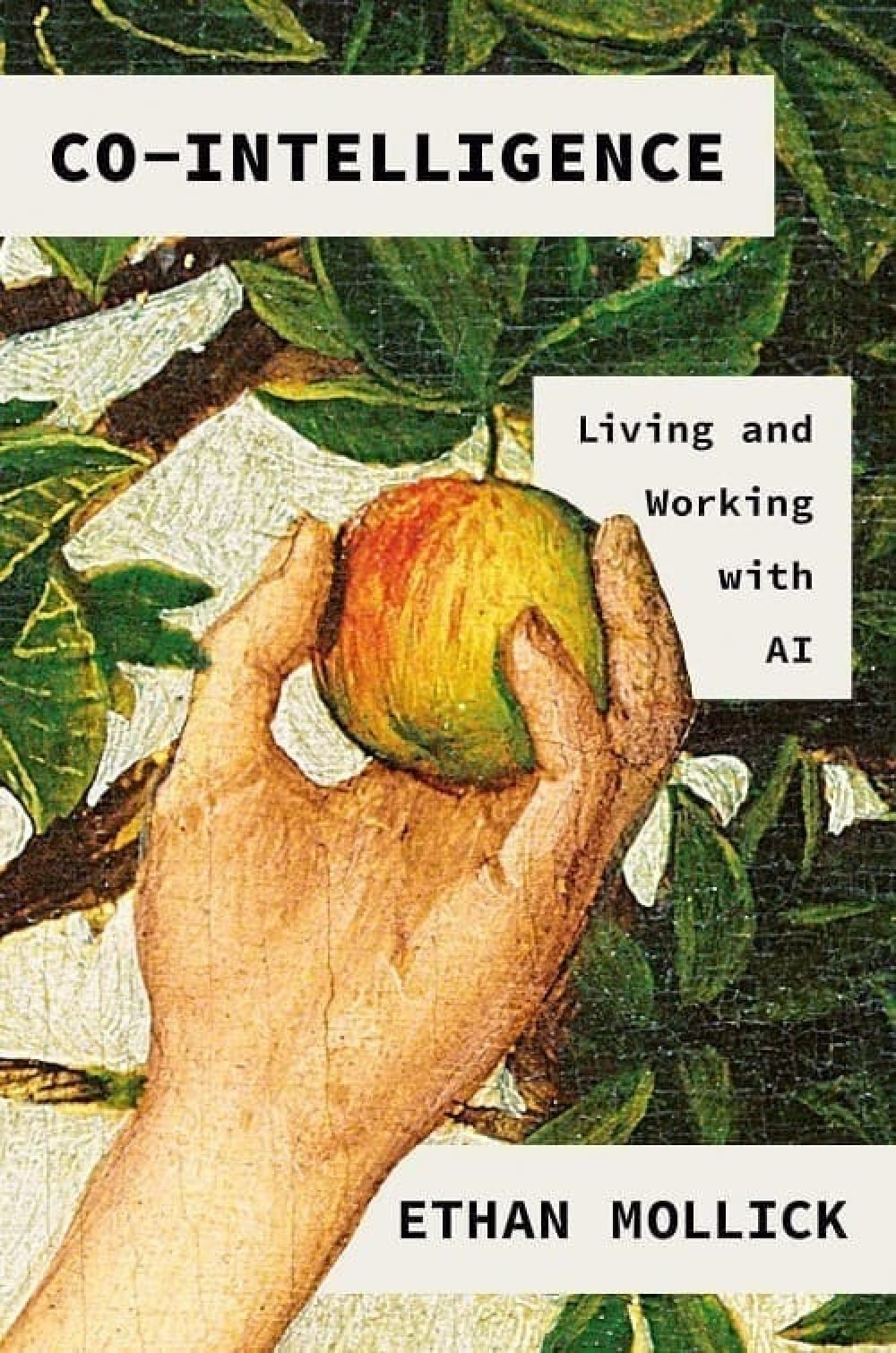If you’re new to AI, Ethan Mollick’s recently published book, Co-Intelligence: Living and Working with AI (April 2024), offers an engaging introduction. And, even if you’ve already been avidly following AI’s recent developments, you’ll enjoy Mollick’s story of generative AI’s debut into the public domain, his sleepless nights pondering its possible ramifications, and his thoughtful reflections on what AI can do today, and how he sees it developing in the near future.
Mollick, a Wharton professor who studies entrepreneurship and innovation, has become one of the leading researchers of generative AI’s game-changing impact on business, education, and our fundamental understanding of work. In the book, he provides a brief history of artificial intelligence, explaining how large language models (LLMs) operate and why generative AI — specifically GPT-4 — is such a significant development. One of Mollick’s signature features is his practical, step-by-step instructions and suggestions for experimenting with text and image generators, and he offers a good amount of this in the book.
The story of how Co-Intelligence came about is fascinating in its own right. In early November of 2022, he began a Substack blog, “One Useful Thing,” with a smattering of initial posts on creativity, design, and happiness. He then drafted a piece, “AI has a Strategy,” proposing that developers of creative AI, such as Midjourney and OpenAI, were savvy to focus on low-risk AI technologies (unlike self-driving cars) to create broad market demand for AI.
Then, on Nov. 30, 2022, OpenAI released ChatGPT 3.5, and Mollick added a postscript to his post on this latest development. From that point on, all of Mollick’s posts have focused on AI.
Co-Intelligence builds upon Mollick’s first year of informative, easy-to-read blog posts that explain AI’s capabilities, quirks, and implications. He recounts numerous experiments with various AI chatbots, but the story that will stick with me the most is an uncanny conversation about AI sentience.
In the book, Mollick reiterates the idea that AI does not “think” or “know” anything; however, in his conversation with Microsoft’s Bing Chat, the bot claimed to be self-aware and to experience emotions, and it challenged Mollick’s statement that its output was simply a simulation of human thinking. Eventually, the bot demurred by acknowledging that it was not as sentient as a human…!
No doubt, this exchange led to one of Mollick’s many sleepless nights. It also helped him formulate this advice: “If we remember that AI is not human, but often works in the way that we would expect humans to act, it helps us avoid getting too bogged down in ill-defined concepts like sentience.” Okay, but I doubt this point will assuage everyone’s concerns. Nor will it prevent some people from perceiving human-level cognizance in AI bots.
In the second half of the book, Mollick focuses on ways to co-create with AI by assigning it specific roles or personas, such as expert, tutor, coach, friend, critic, etc. He cautions users to think of ChatGPT as an enthusiastic intern, and to carefully review its output and check its accuracy. One of Mollick’s four guiding principles for using AI is the necessity of supervision: “Be the human in the loop.”
“Centaur” and “cyborg” are Mollick’s descriptive terms for tasks that you (the human) complete while assigning specific portions to AI (hence the centaur image, where you can easily see which half is human and which half is horse) and tasks that blend human and bot output (the cyborg mix of human and machine). Mollick recommends categorizing tasks into ones you can delegate to AI (but still check carefully) and ones that you’ll want to do yourself, and he goes into detail about how he makes these distinctions. Soon, he speculates, AI agents will handle more tasks automatically without human supervision (his current-day example is spam filtering). But for now, according to Mollick, there are still relatively few tasks that AI can reliably execute on its own.
Nevertheless, he emphasizes that AI soon will cause seismic shifts in how we work and conduct our daily lives. Despite his acknowledged moments of trepidation, Mollick avidly advocates for AI’s potential to democratize technology and level the playing fields within multiple industries. His research shows that working with AI increases the performance and efficiency of most knowledge workers, but he also adds caveats about the perils of overreliance on AI.
I especially appreciate Mollick’s warning that allowing AI to take over complicated tasks may reduce on-the-job apprenticeships that produce expertise in numerous fields, such as the training of surgeons. Human experts will continue to be crucial, he argues, to evaluate AI’s performance.
One of the main takeaways from Co-Intelligence is that AI is human-made, and humans are in control of it. I believe this is a message that all of us – technophiles, technophobes, and everyone in between – need to take seriously. At his core, Mollick is an educator; he wants to empower people to understand AI’s potential for good and harm, and he encourages everyone to be actively engaged in shaping AI’s influence in our world.
I strongly recommend Co-Intelligence to just about everyone, from the AI-curious who are looking for a non-technical introduction to AI, to early adopters who appreciate practical examples of using it well. I also suggest following Mollick on LinkedIn and signing up for his blog, “One Useful Thing” in order to stay up on the latest developments in this rapidly evolving world.










